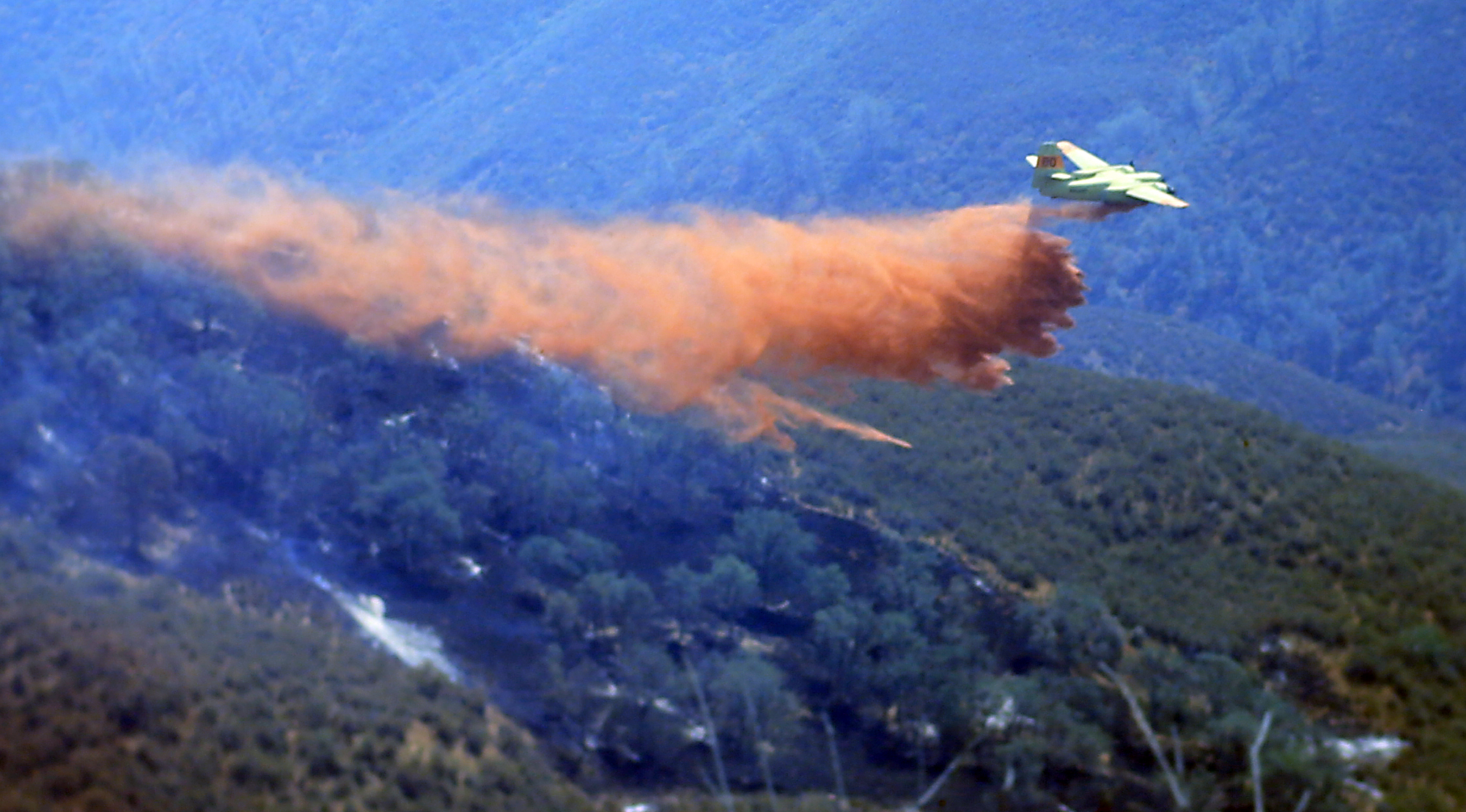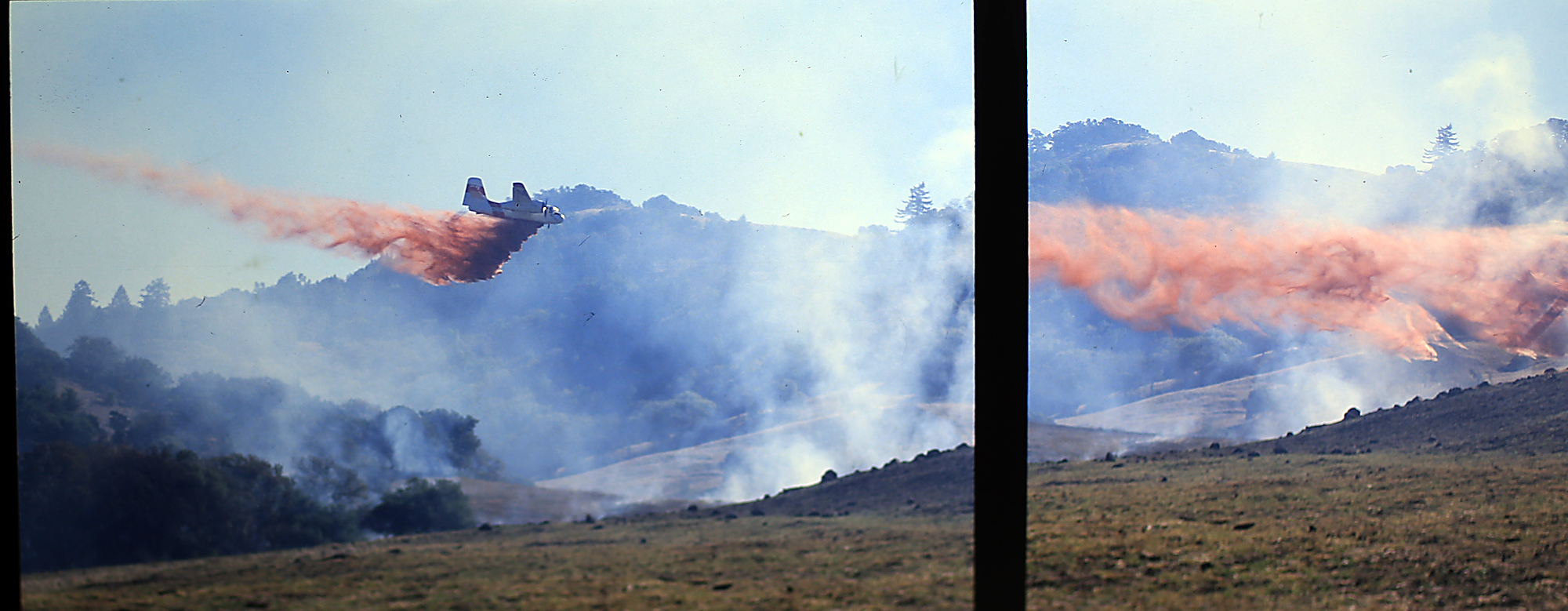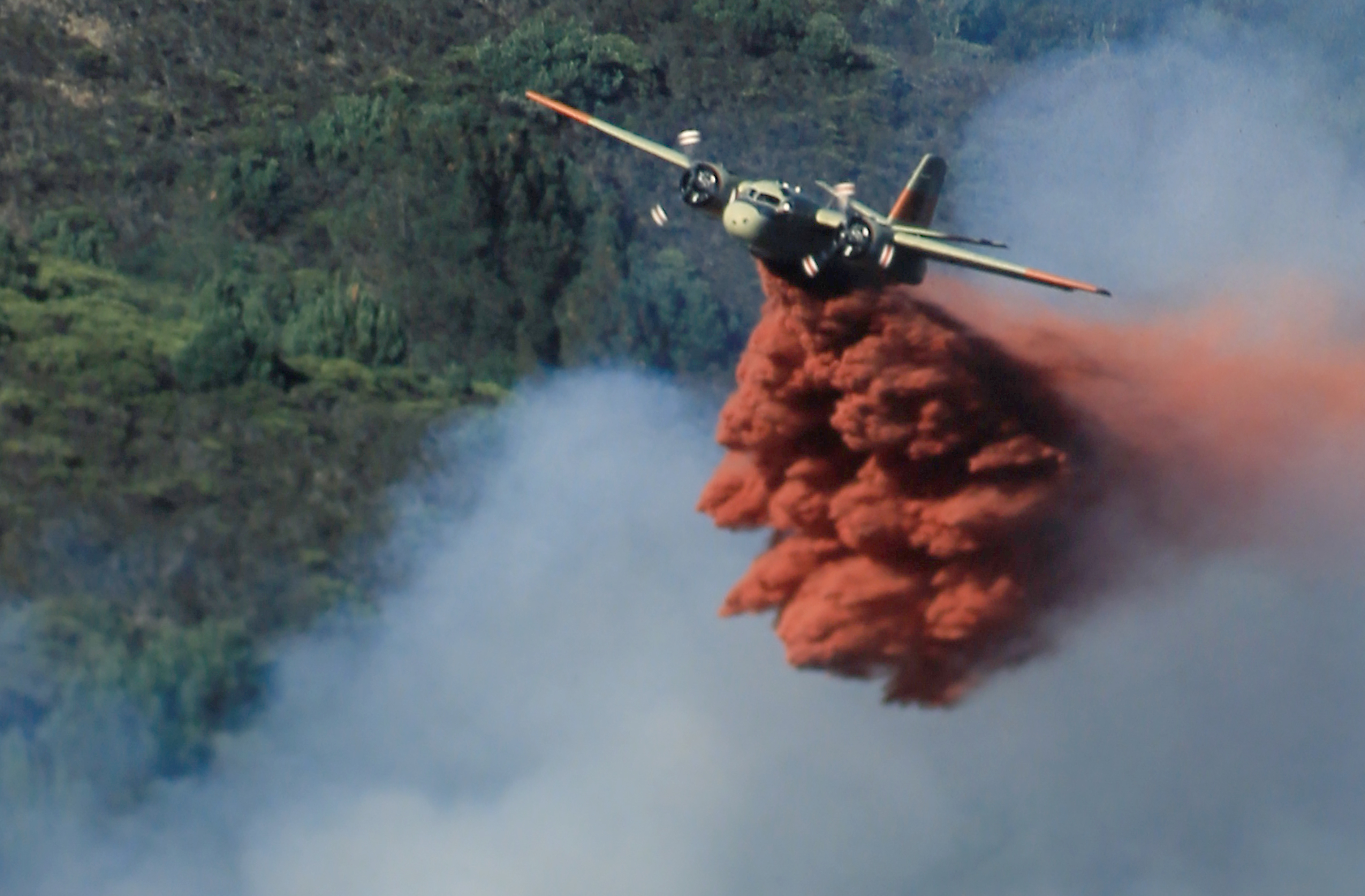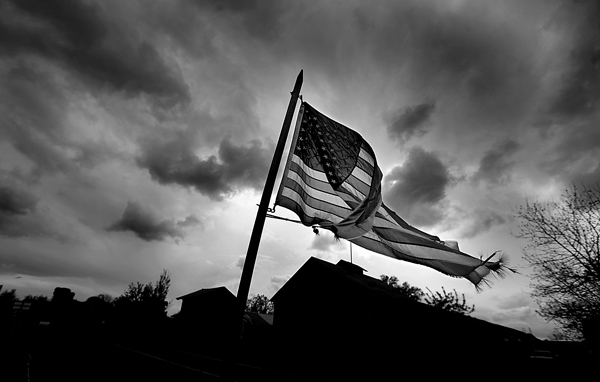I will preface this by stating if you do not like air tanker photos, this post is not for you. Of course you could read it anyway and hopefully I’ve accomplished at least one of the following:
A. You are caustically bored
B. Enlighted
C. Mortified that I would post so many photos
D. Curious as to why someone would photograph so many fires
E. All of the above
The 2013 fire season got off to quick start in early May. Since then, fires that have been fought in Sonoma County this summer have been larger than during a normal year (what’s normal anymore?), at least it seems that way. A few of these blazes in the flat lands have burned 50 acres or more.
It’s not difficult to understand that the vegetation is very dry. Don’t let the July/August gloom fool you even though the stratus is a month late.
Photographically covering a fire you have to be an artistic diplomat, that is, juggling access issues, traffic (because a ton of people show up to watch) and staying safe. Once that’s accomplished, it’s purely work mode. Normally, PD photogs get to blazes after most of the fire is put down. It’s usually a mop-up photo of some type. Not the case this year. We’ve had helicopter dropping photos, flames, people with garden hoses and of course air tankers.
So this got me to thinking (it hurts too) how many tanker drops have I photographed in the past 26 years at the Press Democrat?
After a few hours of digging through some old files, I’ve photographed dozens. Some were okay, some were not so okay and still others I just stuffed back in to the files because they were just plain, well, bad. (Editors, if you read that last sentence, I make up for it by having good fire photos from the same events).
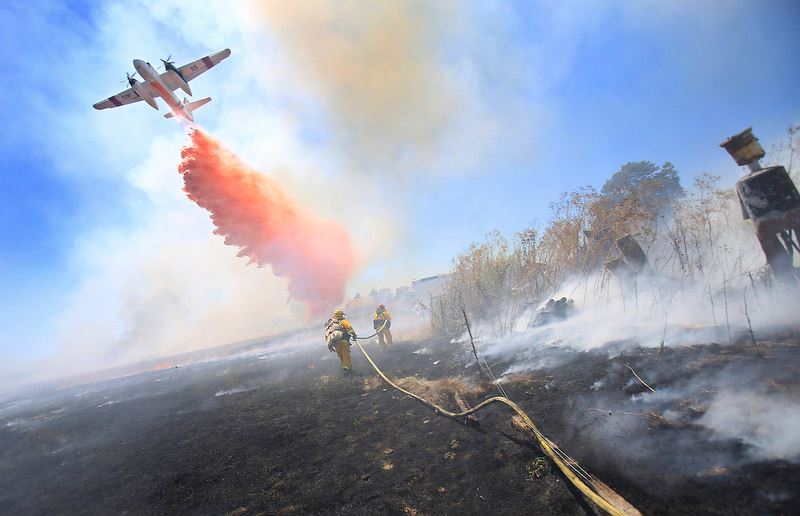
A fire off Todd Road in Santa Rosa that burned 82 acres in July was unusual due to the amount of acreage within the city limits and the numerous air tanker drops. (Kent Porter / Press Democrat) 2013
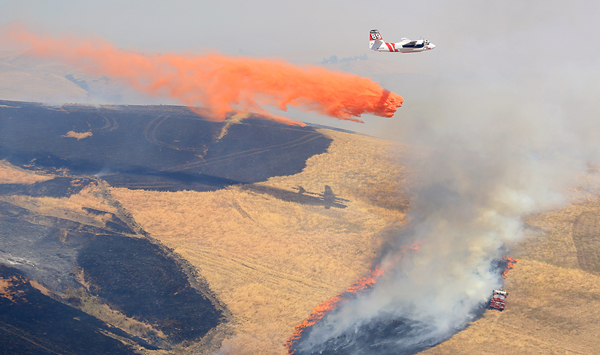
A Cal Fire air tanker based out of Ukiah drops on a spot fire during a large fire off Lakeville Highway near the Pegasus Ranch south of Petaluma, Friday July 26, 2013. (Kent Porter / Press Democrat) 2013
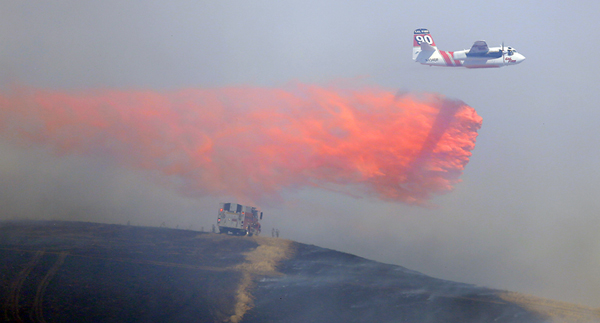
A Cal Fire air tanker based out of Ukiah drops on a spot fire during a large fire off Lakeville Highway near the Pegasus Ranch south of Petaluma, Friday July 26, 2013. (Kent Porter / Press Democrat) 2013
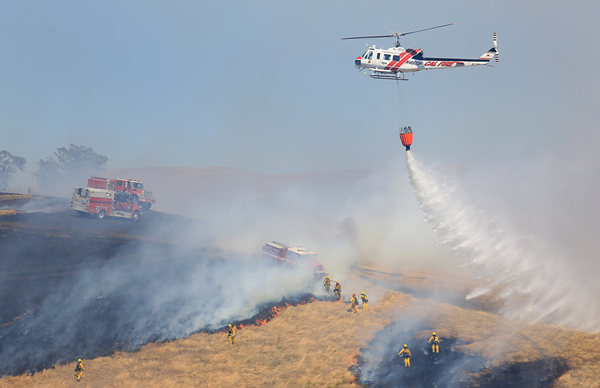
A Cal Fir ehelicopter from Boggs Mountain off Cobb Mountain drops on a spot fire during a large fire off Lakeville Highway near the Pegasus Ranch south of Petaluma, Friday July 26, 2013. (Kent Porter / Press Democrat) 2013
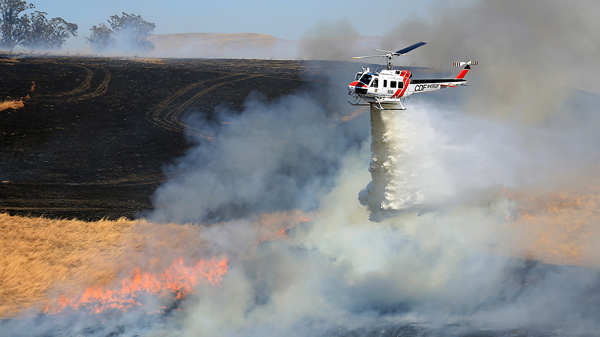
A Cal Fire helicopter from Alma in Santa Clara during a 160 acre fire off Lakeville Highway near the Pegasus Ranch south of Petaluma, Friday July 26, 2013. (Kent Porter / Press Democrat) 2013
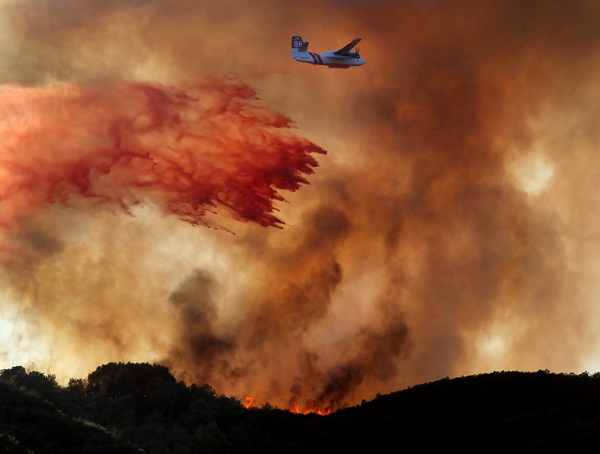
A Cal Fire air tanker drops a load of fire retardant across the head of the Scotts Fire above Scotts Valley in Lake County Friday September 7, 2012. (Kent Porter / Press Democrat) 2012
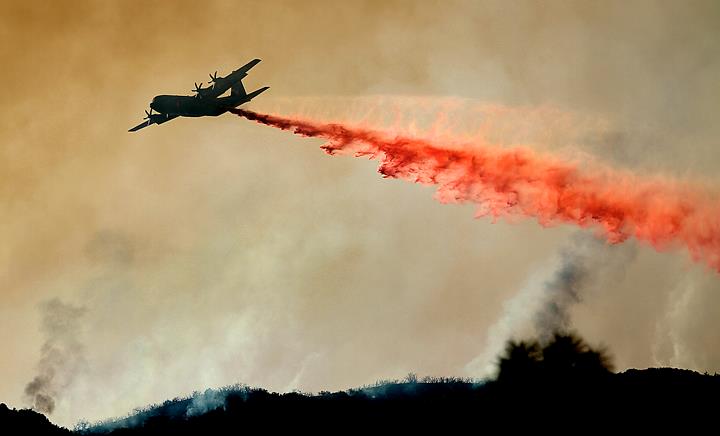
The Modular Airborne Fire Fighting System or MAFFS is a self-contained unit used for aerial firefighting that is loaded onto a C-130 Hercules, is used to help fight the Scotts Fire in Lake County Friday September 7, 2012 (Kent Porter / Press democrat) 2013
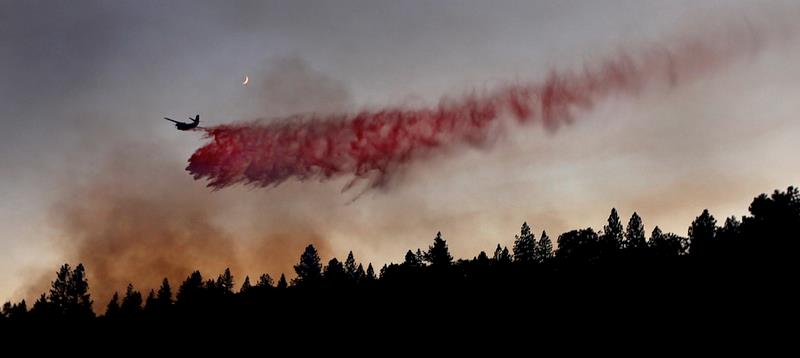
During the last fire of the season near Lower Lake in 2012, an air tanker makes a drop as the sun sets . (Kent Porter / Press Democrat) 2013

A CDF airtanker drops fire retardent on the Rumsey Fire near Blue Ridge October 14, 2004. (Kent Porter / Press Democrat) 2004.
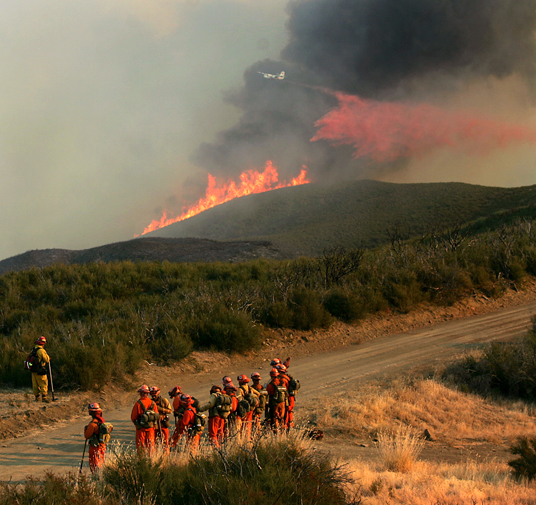
Before building fire line around the head of the Rumsey fire, a CDF airtanker makes a "wet" line around the blaze to help contain the fire; waiting in the wings is a CDF inmate hand crew from Tehama County, October 12 2004. (Kent Porter / Press Democrat) 2004
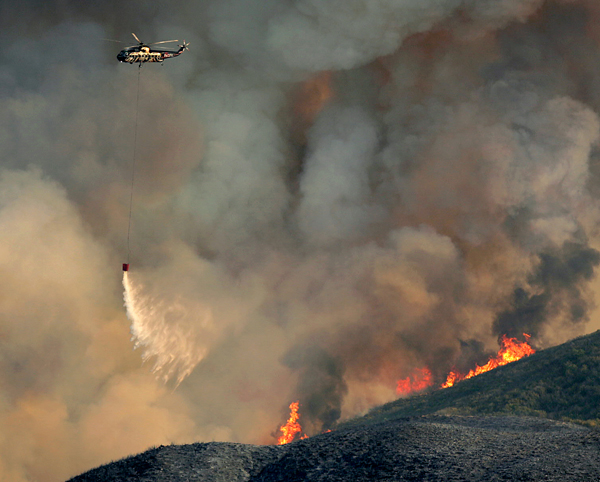
A private hire helicopter dumps water on the Rumsey fire October 12, 2004, South of Rumsey in Yolo County on Blue Ridge in effort to help contain the nearly 37,600 acres wildland fire that has been burning since Sunday. (Kent Porter / Press Democrat) 2004

South of Rumsey in Yolo County, a CDF air tanker builds a line of fire retardant on top of a ridge October 12, 2004, to stop the head of the Rumsey fire from slopping over contaiment lines. The Rumsey fire has grown to nearly 37, 600 acres and is 47 percent contained. (Kent Porter / Press Democrat) 2004
The photo below was shot on the same day as the Rumsey Fire, above. In space of a few hours I traveled about 150 miles to photograph two totally different fires, one wind driven in relatively flat terrain and the Rumsey fire that was terrain and fuel driven. To top that off, a person driving to the fire not associated in any way to the Rumsey incident sideswiped me while going around a blind corner in the other direction. It was his fault though, he was nearly five feet in my lane. I was also stung by a wasp three times on the palm of my right hand that day. What did I do to make that bee mad?
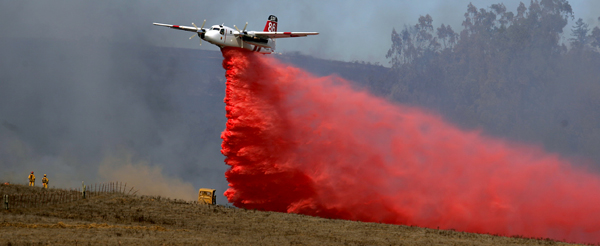
A California Department of Forestry air tanker makes a drop on the head of a grass fire in Valley Ford, Tuesday October 12, 2004. The fire blackened 75 acres. (Kent Porter / Press Democrat) 2004
On an assignment to photograph the Ukiah Train Depot, a fire toned out in Laytonville. The photo below is the first photograph I shot when I parked my vehicle. I was told several times to evacuate the area but the fire started burning downhill against the wind slowing the head quite a bit.
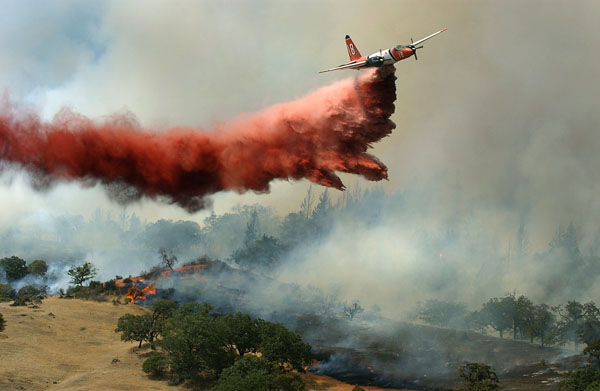
An Aero Union airtanker drops retardent on the Shamrock fire south of Laytonville,Tuesday August 20, 2002. The forest fire had burned 300 plus acres by 4pm with only 15 percent containment. The fire started at Highway 101 and quickly spread up the mountain and briefly threatend the Cherry Creek subdivision. A total of six airtankers and two helicopters were called to help fight the fire, along with numerous strike teams from surrounding counties. (Kent Porter / Press Democrat) 2002
It was my turn to work the Memorial Day weekend in 2001. From the get go it was a busy day. I believe this is a Douglas C-54 then out of Aero Union in Chico.
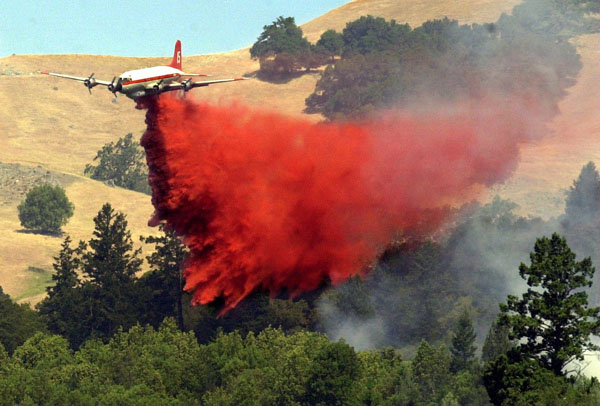
A DC-4 contracted by the California Department of Forestry drops retardent on the head of the fire on Ida Clayton Road in Eastern Sonoma County Wednesday May 30, 2001. Four air tankers and two helicopters were used to help stop the advance of the fire. (Kent Porter / Press Democrat) 2001
Below, when PD photogs shot slide film (remember film?) I motored off several frames of the drop. The then CDF airtankers were green and housed radial engines. The sound the engines made while swooping over a fire is unforgettable, guttural, powerful, iconic. This fire only burned about three acres above Pythian Road but was quite an air show for me and the 200 other people who lined Highway 12, watching. It is the only time I have shot a wildfire with a behemoth Nikon 600mm f4 lens. I think it weighed nearly 100 pounds. Something like that.
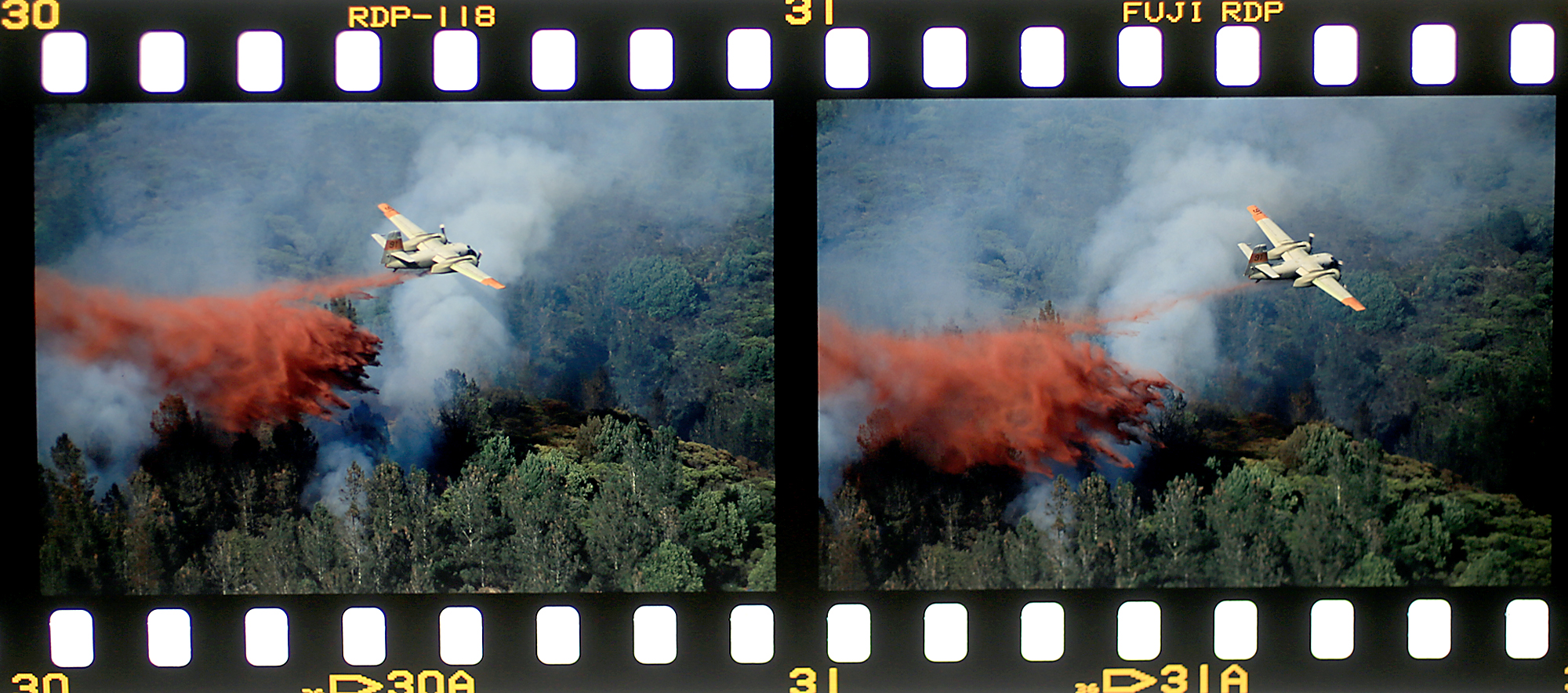
A fire on the slopes of Hood Mountain near Oakmont in Santa Rosa. (Kent Porter/ Press Democrat) 1989
Ah, the Eagle Fire in Lake County. About 2,000 acres in the Cache Creek drainage of Lake County, August 7, 1990. Four-wheeled up to a ridge and shot a few pictures. The blaze was pretty much out by the time I arrived. This area seems to burn nearly every year.

On June 24, 1989, Aero Union again brought out the heavy air tankers to battle an early season blaze, this time on Pine Flat Road above Geyserville. (Kent Porter / Press Democrat) 1989
In 1989, editor George Manes dispatched me and two reporters (Robert Digtale was one of them) to the Mendocino National Forest for the Twin Valley Fire off Bartlett Springs Road in Lake County. Again the fire was out by the time we got there. What I got was this photo and a bunch of images of inmate crews cutting fire line. I also came down with a severe case of poison oak that persisted more than a month after. UGH.
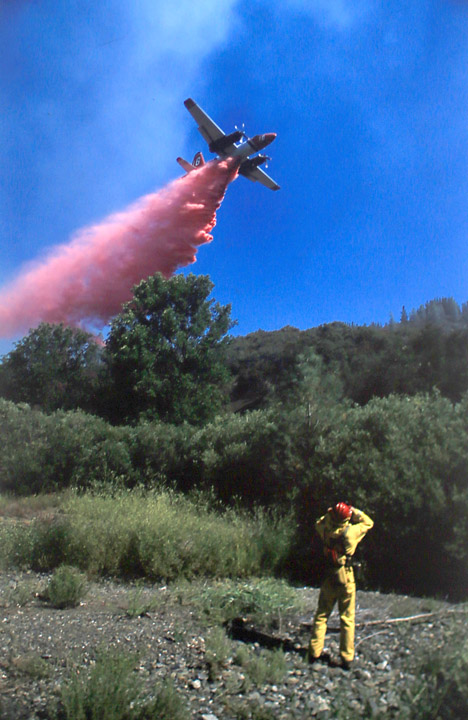
A drop on the Twin Fire in the Mendocino National Forest circa 1990's. (Kent Porter / Press Democrat)
Below is a fire above Boyes Hot Springs in September 1987. The next drop from the bomber painted all of us red. I still have red phos-chek on the 20mm lens used on a Nikon F3 from this first fire I covered a month after being hired by the Press Democrat

A fire in Boyes Hot Springs near Sonoma threatened several homes in 1987. (Kent Porter / Press Democrat) 1987
Pretty much got painted red with the gooey, slippery phos-chek in the photo below. Lenses, cameras, me, ground, bushes and rocks. Everything.
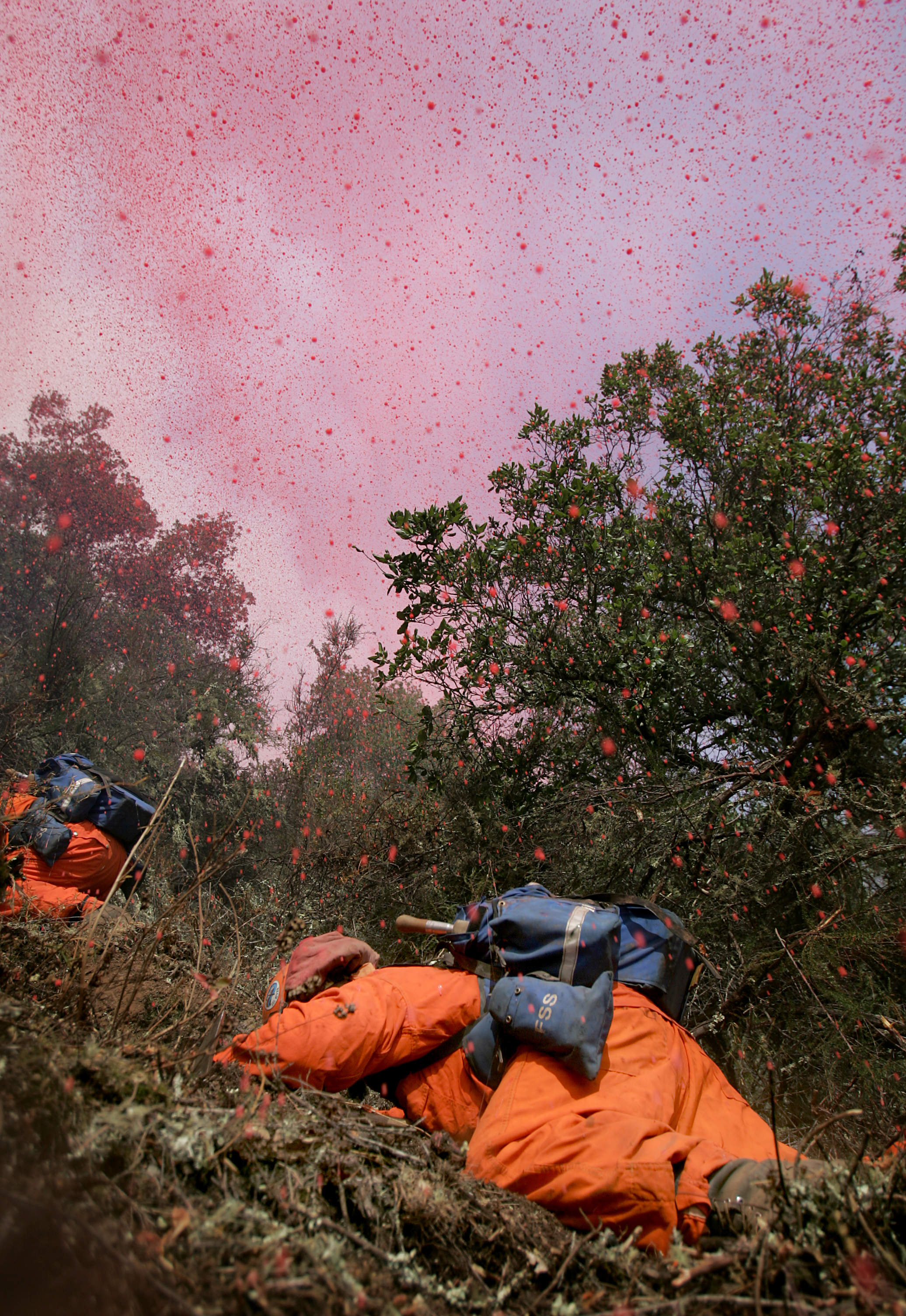
Members of a state Department of Corrections inmate firefighting crew from Humboldt County take cover as an air tanker drops fire retardant on a wildfire just west of Yountville. 9/23/2006:. (Kent Porter / The Press Democrat) 2006
2010 was a relatively slow fire season until this fire in Bodgea. It only burned 100 acres, but severely injured a firefighter by downed power lines.
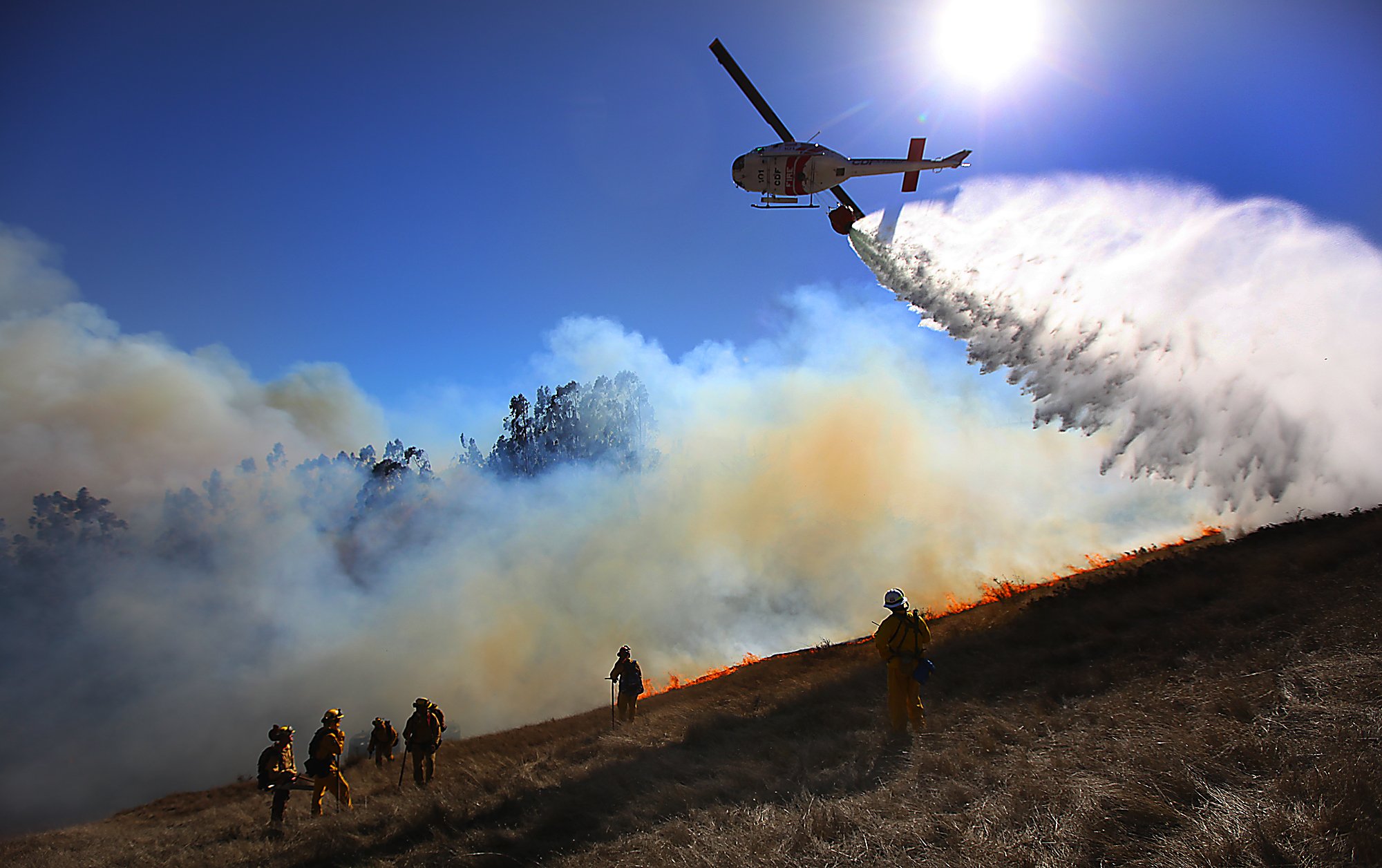
Cal Fire firefighters watch for spots as a helicopter makes a drop on a blaze that swept through 75 acres of eucalyptus and brush, burning one structure in the process in Bodega, Saturday Sept. 25, 2010. (Kent Porter / Press Democrat) 2010

Cal Fire's helitac crew 104 from Boggs Mountain Lake County cut a scratch line in tall grass during a fire that swept through 75 acres of eucalyptus and brush and burning one structure in the process in Bodega, Saturday Sept. 25, 2010. (Kent Porter / Press Democrat) 2010
Reporter Guy Kovner and I were sent to San Diego to cover the Witch Fire in 2007. I was with heavy heart when I left, my dad had died just days before. In retrospect, it was probably the best thing for me. I was able to throw myself in to the coverage and direct my sorrow in to making intense pictures. With very little sleep, a backseat filled with empty Gatorade and water bottles we criss-crossed the Inland Empire several times in search of stories. What we found was devastation. A front page photo of our local strike teams on the front page of the New York Times, three videos and an abundance of images in the Press Democrat brought Redwood Empire readers first hand accounts of the disaster. We also slept one night in a car, because there were no motel rooms available. My back still hurts when I think about that.
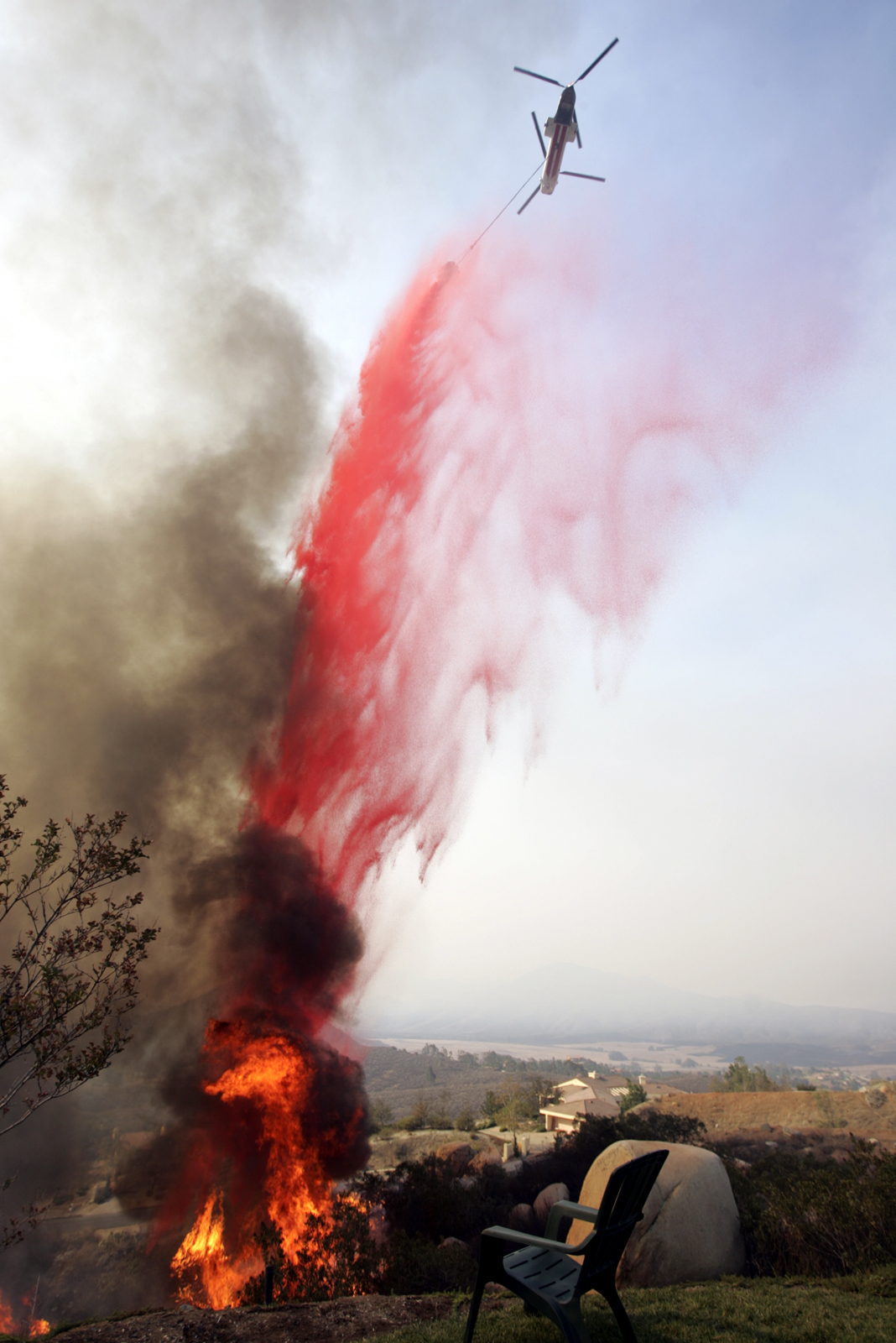
On the Harris fire in Jamul, near El Cajon, a firefighting helicopter drops phoscheck on a hot spot in Jamul highlands, Wednedsay October 24, 2007. (Kent Porter / The Press Democrat) 2007
Then there was October 20, 1991. If any of you remember that day, there were two big fires. One in the Oakland Hills and another in the Geysers. Back before the internet clogged our brains, there were three ways to get weather forecasts. Newspaper, radio and television. On that Sunday, I woke early to prepare for a 49ers football game. When I stepped out on my porch the first time that morning, I was immediately struck by the heat and wind. The temperature was 92 degrees and humidity levels were in the single digits. Winds were a out of the east at 20mph. Maybe I missed the forecast the previous night, it was totally unexpected. I took one look at the Geysers while driving to work and realized football was not in the cards.
So I called boss Jodie Steck and she sent me up to the mountains. What I found up there was unbelievable, winds nearly 60mph. So windy in fact, the tankers were called off. The planes I did see were wobbling in the wind currents. No drops for me that day. I hooked up with a helitack crew from Mendocino County and spent most of the day with them. At one point we all had to sprint down a road to a safety zone because the winds and flame lengths were chewing through brush uncomfortably close to our group. I lost a strobe while running.
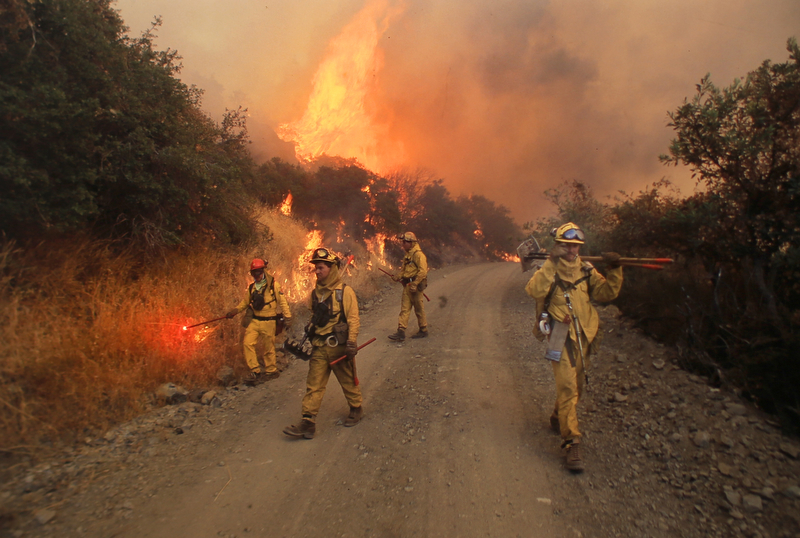
The Howard Forest helitack crew light backfires on a ridge on the Geysers Fire, Oct. 20, 1991. (Kent Porter / Press Democrat) 1991

A member of the Howard Forest helitack crew finds safety on a fire truck as flames chew through decades old brush and grass in the Geysers. (Kent Porter / Press Democrat) 1991

Sometimes, no matter what, you need to keep energy up while fighting fire. (Kent Porter/ Press Democrat) 1991

A fox rests on a fire road during the Geysers Fire in 1991 while outrunning the flames. (Kent Porter / Press Democrat) 1991.
-Kent Porter

